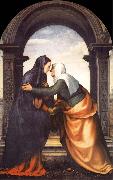Wholesale Oil Painting No Minimum |
|||||||||||
|
|
|||||||||||

|
|||||||||||
|
|
|
||||||||
ALBERTINELLI MariottoItalian Early Renaissance Painter, 1474-1515 Italian painter. Albertinelli's contribution to the Florentine High Renaissance was inspired by the work of FRA BARTOLOMMEO, and the two artists worked together in a partnership, their paintings appearing to be the product of a single hand. Albertinelli, however, always retained artistic independence, as is revealed in certain paintings that are eccentrically archaic and in others that show a preference for conventions more typical of the early Renaissance. |
||||||||
|
|
||||||||
The Visitacion
The Visitacion Painting ID:: 41951 |
mk166
1491
Painting on wood
172x165cm
Museum of the Louvre, Paris mk166 1491 Painting on wood 172x165cm Museum of the Louvre, Paris |
|||||||
|
|
||||||||
Pontormo, Jacopob Pontormo, nr Empoli, 26 May 1494; d Florence, 31 Dec 1556). Italian painter and draughtsman. He was the leading painter in mid-16th-century Florence and one of the most original and extraordinary of Mannerist artists. His eccentric personality, solitary and slow working habits and capricious attitude towards his patrons are described by Vasari; his own diary, which covers the years 1554-6, further reveals a character with neurotic and secretive aspects. Pontormo enjoyed the protection of the Medici family throughout his career but, unlike Agnolo Bronzino and Giorgio Vasari, did not become court painter. His subjective portrait style did not lend itself to the state portrait. He produced few mythological works and after 1540 devoted himself almost exclusively to religious subjects. His drawings, mainly figure studies in red and black chalk, are among the highest expressions of the great Florentine tradition of draughtsmanship; close to 400 survive, forming arguably the most important body of drawings by a Mannerist painter. His highly personal style was much influenced by Michelangelo |
||||||||
|
|
||||||||
|
|
The Visitacion
The Visitacion Painting ID:: 41953 |
mk166
in the middle of the century XVI Painting Church of San Miguel Carmignano mk166 in the middle of the century XVI Painting Church of San Miguel Carmignano |
||||||
|
|
||||||||
|
Pontormo, Jacopo b Pontormo, nr Empoli, 26 May 1494; d Florence, 31 Dec 1556). Italian painter and draughtsman. He was the leading painter in mid-16th-century Florence and one of the most original and extraordinary of Mannerist artists. His eccentric personality, solitary and slow working habits and capricious attitude towards his patrons are described by Vasari; his own diary, which covers the years 1554-6, further reveals a character with neurotic and secretive aspects. Pontormo enjoyed the protection of the Medici family throughout his career but, unlike Agnolo Bronzino and Giorgio Vasari, did not become court painter. His subjective portrait style did not lend itself to the state portrait. He produced few mythological works and after 1540 devoted himself almost exclusively to religious subjects. His drawings, mainly figure studies in red and black chalk, are among the highest expressions of the great Florentine tradition of draughtsmanship; close to 400 survive, forming arguably the most important body of drawings by a Mannerist painter. His highly personal style was much influenced by Michelangelo The Visitacion mk166 in the middle of the century XVI Painting Church of San Miguel Carmignano |
||||||||
|
|
||||||||
|
Prev Next
|
||||||||
|
|
||||||||
|
Related Paintings to Pontormo, Jacopo :. |
||||||||
|
|
||||||||
|
CONTACT US |


